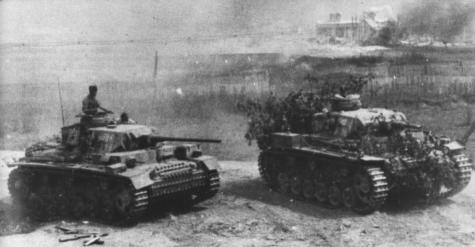
There are 576 cases from World War II in our division-level database. There are no engagements from 1939, only two from 1940, seven from 1941, one from 1942 and the rest are from 1943-45.
World War II (576 cases) – complete data set
Force Ratio…………………….Percent Attacker Wins……………….Number of Cases
0.25 to 0.49………………………22%………………………………………………..9
0.50 to 0.98………………………30…………………………………………………50
1.00 to 1.49………………………55……………………………………………….128
1.50 to 1.96………………………61……………………………………………….117
2.01 to 2.49………………………73…………………………………………………48
2.52 to 2.99………………………82…………………………………………………44
3.00 to 3.49………………………76…………………………………………………41
3.50 to 3.98………………………85…………………………………………………26
4.06 to 5.86………………………68…………………………………………………59
6.17 to 7.90………………………87…………………………………………………15
8.20 to 17.87……………………100…………………………………………………20
This clearly makes our point in spades about the U.S. Army three-to-one rule. Above one-to-one odds the attacker wins over half the time and above two-to-one odds the attacker wins over 70% of the time. This is the un-culled data set. The culled data set with 102 cases removed that are “limited action,” limited attack” or “other” consists of only 474 cases. It shows the following:
World War II (474 cases) – culled data set
Force Ratio…………………Percent Attacker Wins…………………Number of Cases
0.25 to 0.49……………………..25%………………………………………………..8
0.50 to 0.98……………………..43………………………………………………….35
1.00 to 1.49……………………..63………………………………………………..111
1.50 to 1.96……………………..68………………………………………………..102
2.01 to 2.49……………………..83………………………………………………….41
2.52 to 2.99……………………..82………………………………………………….39
3.00 to 3.49……………………..79………………………………………………….33
3.50 to 3.98……………………..84………………………………………………….25
4.06 to 5.86……………………..77………………………………………………….48
6.17 to 7.90……………………..87………………………………………………….15
8.20 to 17.87…………………..100………………………………………………….15
22.84-198.69…………………..100…………………………………………………..2
Again, no surprises in this data, and of course, it parallels the patterns seen in the previous data sets.

How do get a force ratio above 8 that is even meaningful at the divisional level?
Are these attacks on fragmented units trying to perform some sort of holding action?
Well, the 44 engagements above 8-to-1 include:
25050: Brody, Phase I, 7/141944, 39,000 to 3,300 or 11.82 odds
29060: Iwo Jima-final Phase, 3/11-3/16/1945, 32,000 to 2,685 or 11.92 odds
29101: Advance from the Beachhead (Okinawa), 4/02-4/04/1945, 19,082 to 2,000 or 9.54 odds
29101: Advance from the Beach (Okinawa), 4/02-4/04/1945, 22,888 to 1,400 or 16.35 odds
26 from the urban fighting in Manila in March 1945.
33001: Suez Canal Assault, South, 10/6/1973, 30,000 to 3,694 or 8.12 odds
33002: Suez Canal Assault, Center, 10/6/1973, 30,000 to 2,464 or 12.81 odds
6 engagements from mop-up operations in the Channel Ports and around Paris (more urban warfare engagements)
43206 Our River Center (Ardennes), 12/16-12/18/1944, 43,8000 to 5,340 or 8.20 odds
45016: Vorksla Ravine (Kursk), 7/7/1943 13901 to 1281 or 11.41 odds (a mop up operation)
45322-46325, 4 engagements in March 1943 around Kharkov against minimal opposition.
There are a couple of significant combat operations here (Brody, Suez, Our River in Second Ardennes)
A lot of restrictive terrain (or channeling) with enough cover for the defense that they avoided being simply walked right over. It would take time for the offense to bring its numbers to bear.
It’s interesting, because I seem to remember seeing a Depuy Institute Study that showed the attacker had something of an advantage in urban combat, at least as far as U.S. forces in WW2 went.
I discuss our three urban warfare studies in two chapters in War by Numbers. Our first urban warfare is on-line here:
http://www.dupuyinstitute.org/tdipdf.htm
We do not say that the attacker has an advantage in urban combat. What we do say is that everything slows down (advance rates, casualty rates).